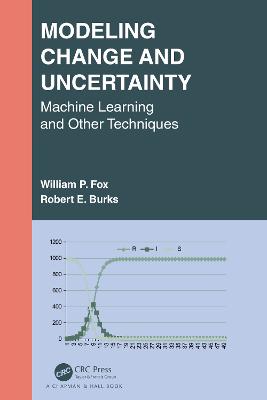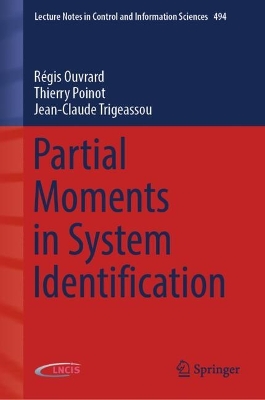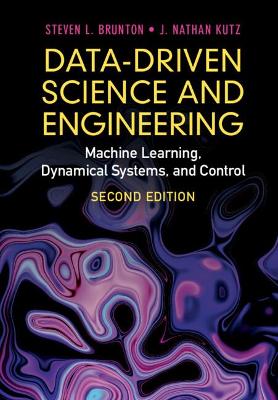Modeling Change and Uncertainty
 portes grátis
portes grátis
Modeling Change and Uncertainty
Machine Learning and Other Techniques
Burks, Robert E.; Fox, William P.
Taylor & Francis Ltd
07/2022
446
Dura
Inglês
9781032062372
15 a 20 dias
1016
Descrição não disponível.
1. Perfect Partners: Combining Models of Change and Uncertainty with Technology. 1.1. Overview of the Process of Mathematical Modeling. 1.2. The Modeling Process. 1.3. Illustrative Examples. 1.4. Technology. 1.5. Exercises. 1.6. Projects. 1.7. References and Suggested Further Reading. 2. Modeling Change: Discrete Dynamical Systems (DDS) and Modeling Systems of DDS. 2.1. Introduction and Review of Modeling with Discrete Dynamical Systems. 2.2. Equilibrium and Stability Values and Long-Term Behavior. 2.3. Introduction to Systems of Discrete Dynamical Systems. 2.4. Iteration and Graphical Solution. 2.5. Modeling of Predator-prey Model, SIR Model, and Military Models. 2.6. Technology Examples for Discrete Dynamical Systems. 2.7. Exercises. 2.8. Projects. 2.9. References. 3. Statistical and Probabilistic Models. 3.1. Introduction. 3.2. Understanding Univariate & Multivariate Data. 3.3. Displays of Data and Statistics. 3.4. Statistical Measures. 3.5. Exercises. 3.6. References. 4. Modeling with Probability. 4.1. Classical Probability. 4.2. Bayes' Theorem. 4.3. Discrete Distributions in Modeling. 4.4. Continuous Probability Models. 4.5. Confidence Intervals and Hypothesis Testing. 4.6. Exercises. 4.7. References. 5. Differential Equations. 5.1. Introduction. 5.1. Qualitative Assessment of Autonomous Systems of First Order Differential Equations. 5.2. Solving Homogeneous and Non-Homogeneous Systems. 5.3. Technology Examples for Systems of Ordinary Differential Equations. 5.4. Exercises. 5.5. Projects. 5.6. References and Suggested Future Readings. 6. Forecasting with Linear Programming and Machine Learning. 6.1. Introduction to Forecasting. 6.2. Machine Learning. 6.3. Model Fitting. 6.4. Time Series Models. 6.5. Case Studies of Time Series Data. 6.6. Summary and Conclusions. 6.7. References and Suggested Readings. 7. Stochastic Models and Markov Chains. 7.1. Introduction. 7.2. Transition Matrices. 7.3. Markov Chains and Bayes' Theorem. 7.4. Markov Processes. 7.5. Exercises. 7.6. References. 8. Linear Programming. 8.1. Introduction. 8.2. Formulating Linear Programming Problems. 8.3. Technology Examples for Linear Programming. 8.4. Transportation and Assignment Problems. 8.5. Case Studies in Linear Programming. 8.6. Sensitivity Analysis in MAPLE. 8.7. Stochastic Optimization. 8.8. References. 9. Simulation of Queueing Models. 9.1. Introduction. 9.2. Queueing Model Practice Problems: Solutions. 9.3. Exercises. 9.4. References. 10. Modeling of Financial Analysis. 10.1. Introduction. 10.2. Simple and Compound Interest. 10.3. Rates of Interest, Discounting, and Depreciation. 10.4. Present Value. 10.5. Bond, Annuities, and Shrinking Funds. 10.6. Mortgages and Amortization. 10.7. Advanced Financial Models. 10.8. Exercises. 10.9. Projects. 10.10. References. 11. Reliability Models. 11.1. Introduction to Total Conflict (Zero-Sum) Games. 11.2. Modeling Component Reliability. 11.3. Modeling Series and Parallel Components. 11.4. Modeling Active Redundant Systems. 11.5. Modeling Standby Redundant Systems. 11.6. Models of Large-scale Systems. 11.7. Exercises. 11.8. References. 12. Machine Learning and Unconstrained Optimal Process. 12.1. Introduction. 12.2. The Gradient Method. 12.3. Machine Learning Regression: A Note on Complexity. 12.4. Genetic Algorithm as Machine Learning in R. 12.5. Initial Population. 12.6. Simulated Annealing. 12.7. Exercises. 12.8. References.
Este título pertence ao(s) assunto(s) indicados(s). Para ver outros títulos clique no assunto desejado.
Mathematical modeling;problem-solving approach;discrete dynamical systems;linear and nonlinear models;statistics and probability modeling;univariate and multivariate data;ordinary differential equations;linear programming;machine learning;decision making;Excel;MAPLE;R;Dynamical systems;data analysis;financial mathematics;regression;Terror Bird;Sir Model;Common Sense Test;Predator Prey Model;Standby Redundant Systems;ARIMA Model;Steady State Probabilities;Exponential Smoothing;Phase Portrait;DDS;Percent Relative Error;Markov Chains;Interarrival Time;Time Inhomogeneous Markov Chains;CTMC;Inter-arrival Time;ANOVA Output;ARIMA;Small MAPE;SA;Recovery Index;Average Percent Relative Error;Cumulative Distribution Function
1. Perfect Partners: Combining Models of Change and Uncertainty with Technology. 1.1. Overview of the Process of Mathematical Modeling. 1.2. The Modeling Process. 1.3. Illustrative Examples. 1.4. Technology. 1.5. Exercises. 1.6. Projects. 1.7. References and Suggested Further Reading. 2. Modeling Change: Discrete Dynamical Systems (DDS) and Modeling Systems of DDS. 2.1. Introduction and Review of Modeling with Discrete Dynamical Systems. 2.2. Equilibrium and Stability Values and Long-Term Behavior. 2.3. Introduction to Systems of Discrete Dynamical Systems. 2.4. Iteration and Graphical Solution. 2.5. Modeling of Predator-prey Model, SIR Model, and Military Models. 2.6. Technology Examples for Discrete Dynamical Systems. 2.7. Exercises. 2.8. Projects. 2.9. References. 3. Statistical and Probabilistic Models. 3.1. Introduction. 3.2. Understanding Univariate & Multivariate Data. 3.3. Displays of Data and Statistics. 3.4. Statistical Measures. 3.5. Exercises. 3.6. References. 4. Modeling with Probability. 4.1. Classical Probability. 4.2. Bayes' Theorem. 4.3. Discrete Distributions in Modeling. 4.4. Continuous Probability Models. 4.5. Confidence Intervals and Hypothesis Testing. 4.6. Exercises. 4.7. References. 5. Differential Equations. 5.1. Introduction. 5.1. Qualitative Assessment of Autonomous Systems of First Order Differential Equations. 5.2. Solving Homogeneous and Non-Homogeneous Systems. 5.3. Technology Examples for Systems of Ordinary Differential Equations. 5.4. Exercises. 5.5. Projects. 5.6. References and Suggested Future Readings. 6. Forecasting with Linear Programming and Machine Learning. 6.1. Introduction to Forecasting. 6.2. Machine Learning. 6.3. Model Fitting. 6.4. Time Series Models. 6.5. Case Studies of Time Series Data. 6.6. Summary and Conclusions. 6.7. References and Suggested Readings. 7. Stochastic Models and Markov Chains. 7.1. Introduction. 7.2. Transition Matrices. 7.3. Markov Chains and Bayes' Theorem. 7.4. Markov Processes. 7.5. Exercises. 7.6. References. 8. Linear Programming. 8.1. Introduction. 8.2. Formulating Linear Programming Problems. 8.3. Technology Examples for Linear Programming. 8.4. Transportation and Assignment Problems. 8.5. Case Studies in Linear Programming. 8.6. Sensitivity Analysis in MAPLE. 8.7. Stochastic Optimization. 8.8. References. 9. Simulation of Queueing Models. 9.1. Introduction. 9.2. Queueing Model Practice Problems: Solutions. 9.3. Exercises. 9.4. References. 10. Modeling of Financial Analysis. 10.1. Introduction. 10.2. Simple and Compound Interest. 10.3. Rates of Interest, Discounting, and Depreciation. 10.4. Present Value. 10.5. Bond, Annuities, and Shrinking Funds. 10.6. Mortgages and Amortization. 10.7. Advanced Financial Models. 10.8. Exercises. 10.9. Projects. 10.10. References. 11. Reliability Models. 11.1. Introduction to Total Conflict (Zero-Sum) Games. 11.2. Modeling Component Reliability. 11.3. Modeling Series and Parallel Components. 11.4. Modeling Active Redundant Systems. 11.5. Modeling Standby Redundant Systems. 11.6. Models of Large-scale Systems. 11.7. Exercises. 11.8. References. 12. Machine Learning and Unconstrained Optimal Process. 12.1. Introduction. 12.2. The Gradient Method. 12.3. Machine Learning Regression: A Note on Complexity. 12.4. Genetic Algorithm as Machine Learning in R. 12.5. Initial Population. 12.6. Simulated Annealing. 12.7. Exercises. 12.8. References.
Este título pertence ao(s) assunto(s) indicados(s). Para ver outros títulos clique no assunto desejado.
Mathematical modeling;problem-solving approach;discrete dynamical systems;linear and nonlinear models;statistics and probability modeling;univariate and multivariate data;ordinary differential equations;linear programming;machine learning;decision making;Excel;MAPLE;R;Dynamical systems;data analysis;financial mathematics;regression;Terror Bird;Sir Model;Common Sense Test;Predator Prey Model;Standby Redundant Systems;ARIMA Model;Steady State Probabilities;Exponential Smoothing;Phase Portrait;DDS;Percent Relative Error;Markov Chains;Interarrival Time;Time Inhomogeneous Markov Chains;CTMC;Inter-arrival Time;ANOVA Output;ARIMA;Small MAPE;SA;Recovery Index;Average Percent Relative Error;Cumulative Distribution Function







